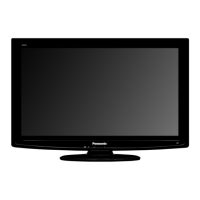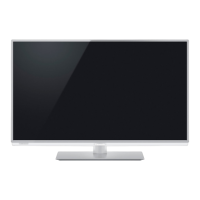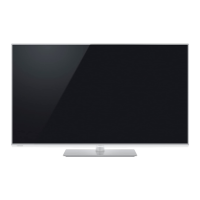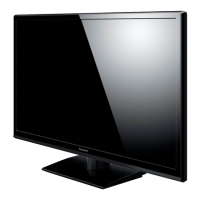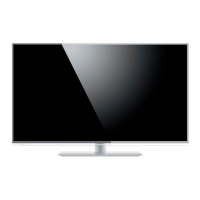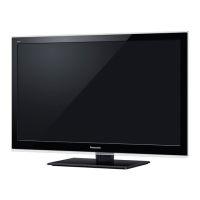Do you have a question about the Panasonic TX-L39E6E and is the answer not in the manual?
Overview of the TV's central hub for accessing content and apps.
Details on "my Home Screen" as a gateway to TV features.
Instructions for navigating and utilizing "my Home Screen" features.
Steps to customize and manage the "my Home Screen" layout.
Guide to connecting the TV to power and essential external devices.
Methods for choosing channels via TV selection, channel list, or info banner.
Explains the on-screen banner displaying channel and program details.
Accessing and adjusting various picture and sound settings.
Setting the TV to automatically switch to standby after a period.
Quickly switching back to a previously viewed channel or input.
Diagrams and instructions for connecting various external devices to the TV.
Details on connecting devices via HDMI, including features and cables.
Connecting analog audio/video devices using component or composite inputs.
Information on connecting USB flash memory and other USB devices.
Steps to select and view content from connected external devices.
Using the TV remote to control connected external equipment.
Overview of HDMI capabilities like audio signals, content type, and ARC.
Pin-out diagrams and descriptions for SCART and HDMI terminals.
Selecting picture presets like Dynamic, Cinema, or Custom for optimal viewing.
Adjusting picture settings automatically based on ambient light conditions.
TV automatically entering standby mode to save energy.
Changing the image aspect ratio for optimal screen fit.
Automatic selection of optimal size and aspect ratio for images.
Detailed adjustments for picture settings like gamma and colour balance.
Copying picture settings from one input or mode to another.
Selecting sound profiles like Standard, Music, Speech, or User.
Navigating and viewing the electronic program guide (EPG).
Accessing and displaying teletext information from broadcasters.
Selecting different teletext display modes like FLOF and List.
Accessing options for channel tuning, list management, and skipping channels.
Creating and managing lists of favorite DVB channels.
Hiding unwanted channels or editing existing channel information.
Automatically searching for and tuning receivable channels.
Manually searching for channels and adjusting frequency.
Updating the channel list with new channels and settings.
Checking the quality and strength of the received TV signal.
Accessing online content like videos and games via the APPS list.
Steps to choose and access specific internet content from the APPS list.
Requirements and methods for connecting the TV to a broadband network.
Setting up wireless or wired network connections for internet access.
Manually configuring wireless network settings via quick setup or custom.
Manually configuring wired network settings, including IP and proxy.
Checking the current network connection status and details.
Configuring settings for controlling the TV via network-connected devices.
Managing network links for controlling the TV with connected devices.
Overview of DLNA for sharing media content across the home network.
Enjoying photos, videos, and music stored on a media server.
Steps to enable and utilize DLNA features for media sharing.
Introduction to using the Media Player for photos, videos, and music.
Choosing the media source (USB, DLNA) and content type (Photo, Video, Music).
Viewing and managing photo files via the Media Player.
Playing and managing video files through the Media Player.
Playing and managing music files via the Media Player.
Accessing various applications like internet and media players.
Manually configuring APPS list settings such as screen and account info.
Overview of HDMI interoperability and simplified control with VIERA Link.
Precautions for safely handling and connecting devices to the TV.
Guidelines for connecting USB flash memory and other USB devices.
Supported photo file formats, resolutions, and standards.
Supported video file formats, codecs, and container types.
List of supported subtitle file formats and naming conventions.
Supported music file formats and copy-protection information.
Frequently asked questions and troubleshooting tips for common issues.
Troubleshooting common picture problems like auto aspect and noisy images.
Solving issues related to digital TV reception and channel tuning.
Troubleshooting common problems with analogue TV reception.
Solutions for no sound or distorted audio issues.
Troubleshooting common problems with HDMI connections and audio.
Solving issues related to network connectivity and DLNA operations.
Addressing miscellaneous issues like VIERA Link errors or overheating.
Instructions for cleaning the TV's display panel, cabinet, and mains plug.
Accessing built-in help for TV self-tests and device information.
Information on optional accessories like communication cameras and wall brackets.
Legal information, trademarks, and software licensing details.
Overview of the TV's central hub for accessing content and apps.
Details on "my Home Screen" as a gateway to TV features.
Instructions for navigating and utilizing "my Home Screen" features.
Steps to customize and manage the "my Home Screen" layout.
Guide to connecting the TV to power and essential external devices.
Methods for choosing channels via TV selection, channel list, or info banner.
Explains the on-screen banner displaying channel and program details.
Accessing and adjusting various picture and sound settings.
Setting the TV to automatically switch to standby after a period.
Quickly switching back to a previously viewed channel or input.
Diagrams and instructions for connecting various external devices to the TV.
Details on connecting devices via HDMI, including features and cables.
Connecting analog audio/video devices using component or composite inputs.
Information on connecting USB flash memory and other USB devices.
Steps to select and view content from connected external devices.
Using the TV remote to control connected external equipment.
Overview of HDMI capabilities like audio signals, content type, and ARC.
Pin-out diagrams and descriptions for SCART and HDMI terminals.
Selecting picture presets like Dynamic, Cinema, or Custom for optimal viewing.
Adjusting picture settings automatically based on ambient light conditions.
TV automatically entering standby mode to save energy.
Changing the image aspect ratio for optimal screen fit.
Automatic selection of optimal size and aspect ratio for images.
Detailed adjustments for picture settings like gamma and colour balance.
Copying picture settings from one input or mode to another.
Selecting sound profiles like Standard, Music, Speech, or User.
Navigating and viewing the electronic program guide (EPG).
Accessing and displaying teletext information from broadcasters.
Selecting different teletext display modes like FLOF and List.
Accessing options for channel tuning, list management, and skipping channels.
Creating and managing lists of favorite DVB channels.
Hiding unwanted channels or editing existing channel information.
Automatically searching for and tuning receivable channels.
Manually searching for channels and adjusting frequency.
Updating the channel list with new channels and settings.
Checking the quality and strength of the received TV signal.
Accessing online content like videos and games via the APPS list.
Steps to choose and access specific internet content from the APPS list.
Requirements and methods for connecting the TV to a broadband network.
Setting up wireless or wired network connections for internet access.
Manually configuring wireless network settings via quick setup or custom.
Manually configuring wired network settings, including IP and proxy.
Checking the current network connection status and details.
Configuring settings for controlling the TV via network-connected devices.
Managing network links for controlling the TV with connected devices.
Overview of DLNA for sharing media content across the home network.
Enjoying photos, videos, and music stored on a media server.
Steps to enable and utilize DLNA features for media sharing.
Introduction to using the Media Player for photos, videos, and music.
Choosing the media source (USB, DLNA) and content type (Photo, Video, Music).
Viewing and managing photo files via the Media Player.
Playing and managing video files through the Media Player.
Playing and managing music files via the Media Player.
Accessing various applications like internet and media players.
Manually configuring APPS list settings such as screen and account info.
Overview of HDMI interoperability and simplified control with VIERA Link.
Precautions for safely handling and connecting devices to the TV.
Guidelines for connecting USB flash memory and other USB devices.
Supported photo file formats, resolutions, and standards.
Supported video file formats, codecs, and container types.
List of supported subtitle file formats and naming conventions.
Supported music file formats and copy-protection information.
Frequently asked questions and troubleshooting tips for common issues.
Troubleshooting common picture problems like auto aspect and noisy images.
Solving issues related to digital TV reception and channel tuning.
Troubleshooting common problems with analogue TV reception.
Solutions for no sound or distorted audio issues.
Troubleshooting common problems with HDMI connections and audio.
Solving issues related to network connectivity and DLNA operations.
Addressing miscellaneous issues like VIERA Link errors or overheating.
Instructions for cleaning the TV's display panel, cabinet, and mains plug.
Accessing built-in help for TV self-tests and device information.
Information on optional accessories like communication cameras and wall brackets.
Legal information, trademarks, and software licensing details.
| Screen Size | 39 inches |
|---|---|
| Resolution | 1920 x 1080 pixels |
| Display Type | LCD |
| Backlight Type | LED |
| HDMI Ports | 3 |
| USB Ports | 2 |
| Wi-Fi | Yes |
| Audio Output | 20 W |
| 3D | No |
| Smart TV | Yes |
| Refresh Rate | 100 Hz |
| Energy Efficiency Class | A+ |




